Author of “Lost Stories of West Coast Latino Boxing”
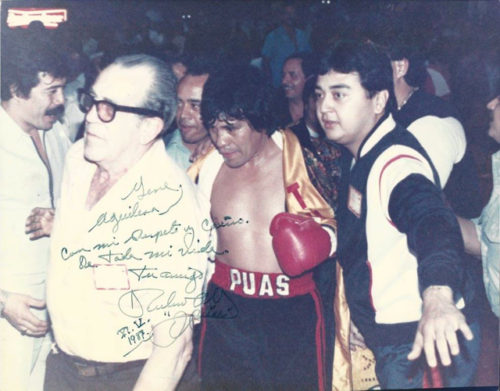 Boxing has long been prevalent in Southern California as crowds flocked to legendary venues like the Olympic Auditorium.
Boxing has long been prevalent in Southern California as crowds flocked to legendary venues like the Olympic Auditorium.
One boxing historian and author lived through the golden ages of the sport and has authored three books chronicling his time with champions through the decades.
Gene Aguilera’s third and newest title “Lost Stories of West Coast Latino Boxing” is out now and just like this other two publications (“Mexican American Boxing in Los Angeles” and “Latino Boxing in Southern California”), his latest contribution to boxing history is just as entertaining and fascinating as his first two books.
Boxing fans, I highly recommend this book “Lost Stories of West Coast Latino Boxing.” It’s a great read for the novice boxing fan to hardcore veteran old-timers and everyone else in between! The compact size is perfect and the format gives readers the option of flipping through the pages to see which photos capture their attention or covering each chapter and studying about the rich history of the West Coast. I give it two fists up–a welcome addition for every library!
And it was a treat catching up with the author of this new boxing title.
Respected and loved in boxing circles, Aguilera’s is known for his upbeat personality and his passion for the fight game. His books burst forth with iconic photos, rare pictures, amazing anecdotes, and behind-the-scenes memories that he shares with his readers. It is his great attention to detail that will have you hooked on his books. His entertaining style of writing coincides with photos of a bygone era and puts your right in the action as he recounts his recollections from these glory days.
Famous faces are included in his newest tome, but many contenders and prospects are also talked about and remembered. Ringside action is plentiful but gym sessions are also showcased. Vintage posters, old advertisements, and magazine covers also line the pages and chapters of Aguilera’s latest work.
For this article, I asked Gene to choose a few of his favorite photos to go along with this interview. He told me he had hundreds and hundreds of photos from a lifetime of taking pictures and putting them in albums. There is no doubt how much the historian/writer loves pugilism!
The boxing alum continues to live in the SoCal area with his wife Maria and their two daughters, Emily and Melanie. He stays busy in the fight community and is a popular fixture at local events.
My interview with Aguilera covers a lot of ground; it’s always a pleasure catching up with someone who respects and reveres the sweet science so much. Read below as the best-selling author reveals which memento means the most to him, how he would change certain aspects of boxing, who will be featured in his next writing, and where you can meet him to purchase your own autograph copy of his books!
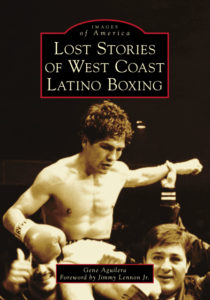 Michele Chong: Hi Gene, congrats on your third book! I really enjoyed reading it and it fits nicely into your series of boxing books.
Michele Chong: Hi Gene, congrats on your third book! I really enjoyed reading it and it fits nicely into your series of boxing books.
Gene Aguilera: Thank you Michele, I appreciate your kind words and all that you do for the great sport of boxing! Well, here it is, my third book, released by Arcadia Publishing on October 11, 2021. The trilogy is now complete. I write about what I know best, what I love, and what I lived . . . which is the Latino/Mexican American side of Los Angeles boxing.
While writing and recounting the anecdotes for this new book, Lost Stories of West Coast Latino Boxing, I wanted to make sure the lost stories and epic battles that went down at the Olympic Auditorium and the Forum would never be forgotten. I wanted to make sure the boxer’s backstories and memories live on forever through this book. And these are the deep stories of Latino boxing—not just the general, everyday folklore. As boxing writer David A. Avila stated in The Sweet Science, “Sports in L.A. has always had a slightly different feel to it largely because of its Latino heritage. Aguilera captures it perfectly. A lot of nuggets are captured in his third book. Items and facts that won’t be found in any other boxing novel or publication. I still look at the same pages I’ve read over and over. There’s magic in the pages. Boxing magic.”
MC: Your first book was in black-and-white. In your second book, you switched to color photos. And for this third title, you went back to the black-and-white photos which suit the mood of the era. What prompted you to go back to the black-and-white images?
GA: I received so many compliments on my first book that I decided to go back to that classic black-and-white noir look. Since the book begins in the early 1900s (with Solly Garcia Smith and Bert Colima), it made sense to go back to black-and-white photos again. And what I’ve heard so far about this third book, Lost Stories of West Coast Latino Boxing, people are really loving it.
SIDEBAR: A couple of months ago, I was surprised and happy to find out my first book “Mexican American Boxing in Los Angeles,” (released in 2014 by Arcadia Publishing) was listed as #56 on the “100 Best-Selling Boxing Books of All Time” by BookAuthority.org as featured on CNN, Forbes, and Inc. That was quite the honor. And this was the first time in my life that I did not mind being #56 in something.
MC: Congrats, Gene! That’s very cool. So just for fun, please describe each of your three titles in just ONE word:
GA: Mexican American Boxing in Los Angeles: BROWN; Latino Boxing in Southern California: COLOR; Lost Stories of West Coast Latino Boxing: DRAMA
MC: Also, please talk about the three covers (Herman Montes, Carlos Palomino and Adrian Arreola) chosen for each book. What comes to mind when you see them on your three books?
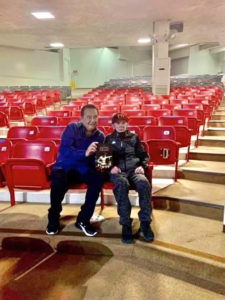 GA: My first book has Herman Montes on the cover—a talented and tough lightweight contender during the 1970s-1980s. If he was fighting today, he would have been a three-time world champion. I was happy with Montes on the cover because it showed a theme of victory with his hand being raised in the air by referee John Thomas. The cover photo, taken by Chris Garcia, also shows ring announcer Jimmy Lennon Sr. and Montes’ father, John (on the far left) after a fight at the Olympic Auditorium.
GA: My first book has Herman Montes on the cover—a talented and tough lightweight contender during the 1970s-1980s. If he was fighting today, he would have been a three-time world champion. I was happy with Montes on the cover because it showed a theme of victory with his hand being raised in the air by referee John Thomas. The cover photo, taken by Chris Garcia, also shows ring announcer Jimmy Lennon Sr. and Montes’ father, John (on the far left) after a fight at the Olympic Auditorium.
The second book shows Carlos Palomino on the cover–taken at the Olympic Auditorium. He was one of the Southland’s most talented and popular boxers ever and WBC welterweight champion from 1976-1979. This photo shot from 1998 is very special to me because it was Carlos’s last fight as a professional. Palomino made an incredible comeback to the ring at age 47 (after being retired for 17 years) and I was glad to be a part of it and witness it all.
For my third book, Boyle Heights featherweight Adrian Arreola was chosen to be on the cover. A mountain of applause goes to photographer Carlos Baeza for such a great shot. This cover also signifies triumph, as it shows Adrian being lifted on the shoulders of his brother Memo Arreola and friend Jesse Ornelas after a stunning TKO victory over former WBC bantamweight champion and Hall of Famer Lupe Pintor at the Olympic.
MC: You’ve appeared at various book signing events around the Southland. What has the response been at these in-person events and do you have any future signings coming up?
GA: Since the book’s release in October 2021, we’ve been attending events and signing books at the Arts District Brewing Co. in Los Angeles, the West Coast Boxing Hall of Fame, Golden Boy Promotions press conferences, La Habra Rotary Club, Pomona Public Library, and King Richard’s Antique Center. We’re getting the word out there and it keeps getting better and better all the time.
To kick off 2022, we will be at Maria’s Grill in Downey on January 21, Arts District Brewing Co. on January 22, and El Pollo Fino in Anaheim on January 23. Our 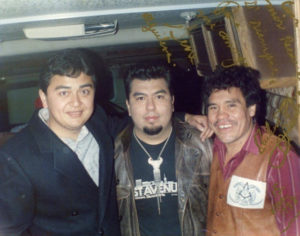 special guest (all the way from Mexico City) will be Hall of Famer, four-time world champion Ruben Olivares—considered one of the greatest bantamweights of all time. Thanks to author Chris Smith for making the above events happen. Also, we will be booking an event at Tamayo’s Restaurant in East Los Angeles and look forward to the National Boxing Hall of Fame at the Quiet Cannon in Montebello on April 24, 2022. Look at Facebook and Instagram for future information.
special guest (all the way from Mexico City) will be Hall of Famer, four-time world champion Ruben Olivares—considered one of the greatest bantamweights of all time. Thanks to author Chris Smith for making the above events happen. Also, we will be booking an event at Tamayo’s Restaurant in East Los Angeles and look forward to the National Boxing Hall of Fame at the Quiet Cannon in Montebello on April 24, 2022. Look at Facebook and Instagram for future information.
MC: You’ve remained close friends with Ruben Olivares since the 70s. Describe what it’s been like knowing the champ?
GA: Ruben and I have a very special friendship and relationship. He has opened many doors for me in the world of boxing. I was introduced to Ruben by his cornerman Jo Jo Torres back in the 70s, and we have been great friends since then. I have been an advisor/representative/cornerman to Ruben, whom I consider one of my closest friends. Olivares and his wife Elba also baptized my second daughter Melanie and we are proud to call them our compadres. So there is a lifetime bond with the champ that will never be broken.
Ruben was inducted into the International Boxing Hall of Fame in Canastota, New York in 1991 (in only their second year of existence) and we have attended almost every year since then. That’s how special Ruben’s role is in the history of boxing and his popularity there is another testament to his greatness.
MC: If you were to choose just ONE item from all of your boxing memorabilia collected through the years, can you name a favorite piece and why it is your very favorite souvenir?
GA: After one of Ruben Olivares’ fights at the Forum, he presented his boxing trunks to me. You can see the trunks on page 35 of my new book. I had the trunks framed along with the picture. That is my favorite piece of boxing memorabilia that I own. Priceless.
MC: Boxing has certainly changed through the years. What do you miss most from the past years in the sport that we don’t have nowadays?
GA: Michele, for boxing to continue and grow, changes must be made sooner than later. The old-timers are just not following it like they used to.
A As of this moment, there are four major sanctioning bodies: WBC, WBA, IBF, and WBO. From this point on, let’s please not add any more new ones.
2) There can only be ONE belt only and ONE champion for each weight division. For example, for the lightweight division, we CANNOT have a regular lightweight champion, a franchise lightweight champion, an interim lightweight champion, and a super lightweight champion. This must stop NOW! This mentality must stop for the sport to survive.
3) For us viewers out there, not every fight is PPV worthy. It seems almost every fight we watch these days comes at an extra cost, and most are not worth the view.
Also, in my opinion, weigh-ins should be on the day of the fight (not the day before the fight). There must be some kind of hydration clause that forbids a boxer 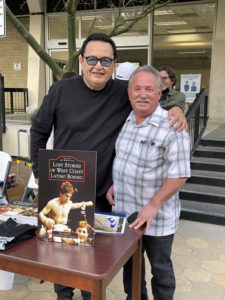 to jump up three divisions in one day (for example) by gaining 20 pounds after the weigh in. This advantage makes the fight a mismatch. If weigh-ins are on the day of the fight, it gives the boxers less of a chance to put on that extra weight.
to jump up three divisions in one day (for example) by gaining 20 pounds after the weigh in. This advantage makes the fight a mismatch. If weigh-ins are on the day of the fight, it gives the boxers less of a chance to put on that extra weight.
These are the complaints that I hear the most from long-time, tried-and-true boxing fans.
MC: Thanks for sharing your thoughts, Gene! What is it about boxing that has made you loyal to the sport after all these years? It’s great looking at all the vintage photos you’ve included in the book; you’re seen in many of them.
GA: While in the process of selecting photos for my new book, I began noticing “There I am” with some of the particular boxers I was writing about. Voila! Proof positive and validation that I lived through local boxing history. There I am with promoter Don Fraser, Eastside heavyweight boxer Eddie “The Animal” Lopez, bantamweight champion Carlos Zarate at the Main St. Gym, and walking Ruben Olivares into the ring at the Forum. I believe it documents my involvement with boxing and shows the longevity and connection that I have with our wonderful sport throughout the years.
MC: If you could travel back in time, name ONE fight from the past that (if you could), you’d watch live and in person?
GA: If I could go back in time, I wish I could have sat ringside for the Bobby Chacon-Bazooka Limon 4 fight that took place in Sacramento, California on December 11, 1982. I remember watching it at my apartment in Montebello on a little 10” black and white TV. I went wild, jumping up and down, screaming my lungs out! Never have I seen such a brutal fight to the end as Chacon-Limon 4
It was a battle of the ages. A grudge fight between two guys who simply did not like each other.
MC: You’ve been involved in banking, music and boxing. Did your passions ever intersect through the years?
GA: I’ve been known to say “My passions are Boxing, Music, and Real Estate. Not necessarily in that order.” I retired from my banking job in 2019 after 37 straight years there. I’ve managed musical acts like The Blazers and Little Willie G. (former legendary lead singer of East L.A.’s Thee Midniters). I arranged to have Little Willie G. sing the National Anthem at the Forum before a Jorge “Maromero” Paez fight in 1997. I hung out with Los Lobos for many years. I have written songs with Ry Cooder and Danny O’Keefe. Danny and I wrote a song “El Corazon Mexicano” that was inspired by my second boxing book.
I have been involved with boxing since the 1970s. I was so hardcore that I used to go to the Olympic Auditorium by myself when I couldn’t get anyone else to go with me. One fight stands out that I attended solo—the Salvador Sanchez vs. Juan Escobar war at the Olympic in 1978. I was always good at sales and promotion, so at all these real estate events, concerts, and boxing matches, I constantly passed out my bank business card and got a lot of loans out of it.
MC: For this article, I had asked you to send me some of your most memorable pictures. Thanks for submitting six photos that are some of your favorites. Can you give a description (thoughts/memories) of why these particular pics are special to you?
GA: Photo #1 is the cover of my brand new book: Lost Stories of West Coast Latino Boxing. I am very proud of this, my third book. I feel my writing has improved every time and the response from the public has been very encouraging to me. It makes me want to continue on and write a few more books.
Photo #2 This is a photo of the great bantamweight champion Eder Jofre, of Brazil, and myself at the Olympic Auditorium in October, 2021–the site where Jofre won his first world title in 1960 against Eloy Sanchez. I can only imagine what was going on in Mr. Jofre’s head while he visited the Olympic Auditorium for the first time since winning the championship.
Photo #3 This is a picture of the popular WBC bantamweight champion Alberto Davila and myself at a book signing in December, 2021 at Pomona Public Library (and Alberto’s hometown). I thank Alberto so much for attending this function as my guest. Davila will always be known as one of the best boxers to come out of Southern California.
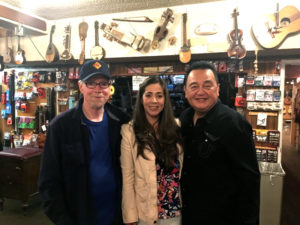 Photo #4 This picture is of singer/songwriter Danny O’Keefe, my wife Maria Aguilera, and myself taken at McCabe’s Guitar Shop in Santa Monica (circa 2019) after O’Keefe’s concert there. Danny is a true boxing fan and was inspired to write a song “El Corazon Mexicano” after reading my second book Latino Boxing in Southern California. Danny, thank you for the co-credits on this song. It is an honor to write a song with the same person who penned the classic hit “Good Time Charlie’s Got the Blues,” covered by hundreds of artists.
Photo #4 This picture is of singer/songwriter Danny O’Keefe, my wife Maria Aguilera, and myself taken at McCabe’s Guitar Shop in Santa Monica (circa 2019) after O’Keefe’s concert there. Danny is a true boxing fan and was inspired to write a song “El Corazon Mexicano” after reading my second book Latino Boxing in Southern California. Danny, thank you for the co-credits on this song. It is an honor to write a song with the same person who penned the classic hit “Good Time Charlie’s Got the Blues,” covered by hundreds of artists.
Photo #5 Another photo I am so proud of that is framed and hanging at my house. From left to right is Phil Silver (cutman), Ruben Olivares, and myself as we enter the ring at the Forum in 1986. Olivares is a four-time world champion (two times bantamweight and two times featherweight) who fought at the Forum a record number of 22 times. No other boxer comes close to that number of appearances at that venue. Hall of famer Olivares also baptized my daughter Melanie and has been a great friend since the 1970s. I give him all the credit in the world for getting my name out there in the boxing world.
Photo #6 This is a photo of Cesar Rosas (vocalist and guitarist for Los Lobos), former world champion Ruben Olivares, and myself at the filming of Los Lobos video for their #1 worldwide hit song “La Bamba” in 1987. We are in the band’s tour bus as they filmed in the parking lot of the Los Angeles Sports Arena during the closing hours of a community carnival, complete with a merry-go-round and other rides.
MC: So many amazing memories! Will there be a fourth title released in the next 3-4 years? And if yes, can you give us a clue on which niche you will choose for it?
GA: Yes, Michele, there will be a fourth title released in 2023. Of course, it will be about Mexican American boxing, but with a distinct concentration on seven boxers only. One clue, because you are such a friend . . . “Schoolboy” Bobby Chacon.
MC: That sounds great! I knew Bobby for many years before he passed away. How can people order your current books that are out now?
GA: You can order my book through Arcadia Publishing, Amazon, eBay, OfferUp, or through me directly if you like. My email address is: geneaguilera@sbcglobal.net or you can find me on Facebook and Instagram.
MC: And finally, please feel free to add any additional thoughts or comments!
GA: Michele, I want to personally thank Jimmy Lennon Jr. for writing the Foreword to my new book, “Lost Stories of West Coast Latino Boxing.” To me, he is the direct link from the old Olympic Auditorium until now. Much appreciation goes to producer/director Steve DeBro of the documentary “18th & Grand” for connecting me with Mr. Lennon Jr., whom I consider one of the greatest ring announcers ever.
Also, a thunderous thank you and appreciation to the boxers who have attended recent book events, such as Danny “Little Red” Lopez, Alberto Davila, Eder Jofre, Carlos Zarate, and Greg Puente. And thank you to you, Michele, for this enjoyable interview. I had a lot of fun!
Look for more of Gene Aguilera’s work in the future as his next printed book will be released in 2023. I’m already looking forward to reading it.
Photos courtesy of Gene Aguilera


Great interview of Gene Aguilera. Very inspiring and passionate
Comments are closed.